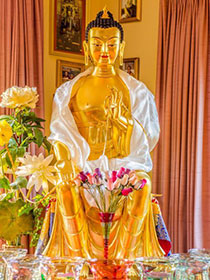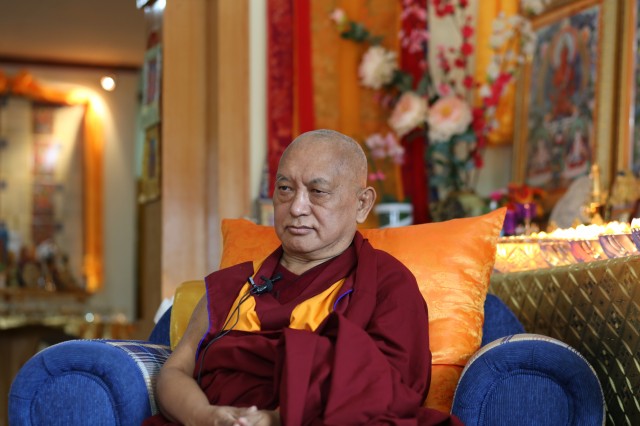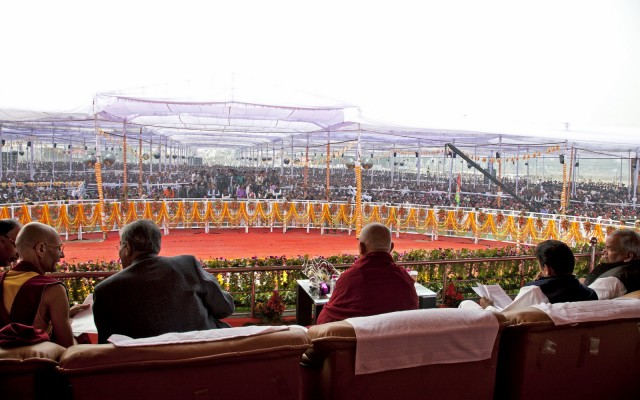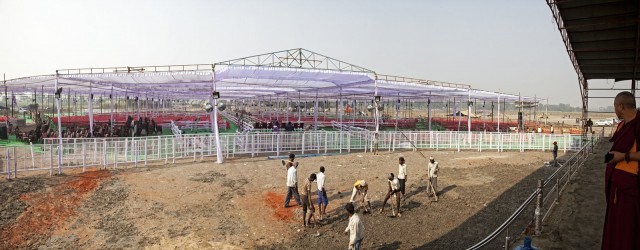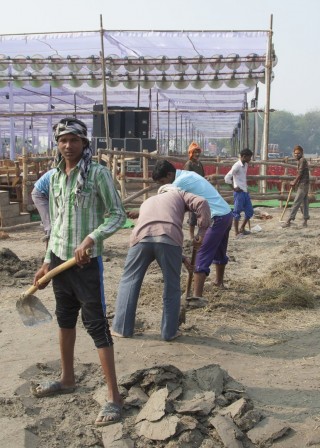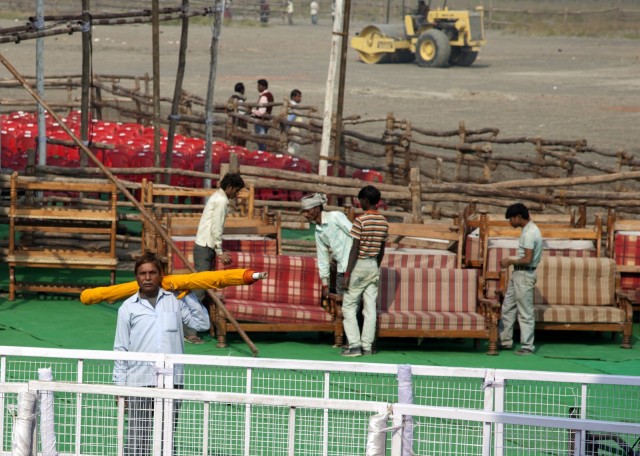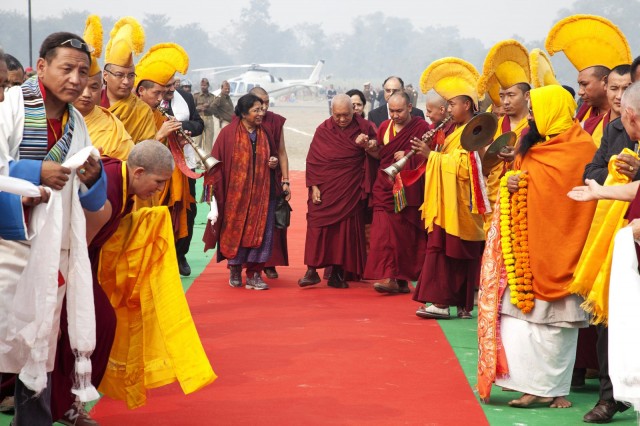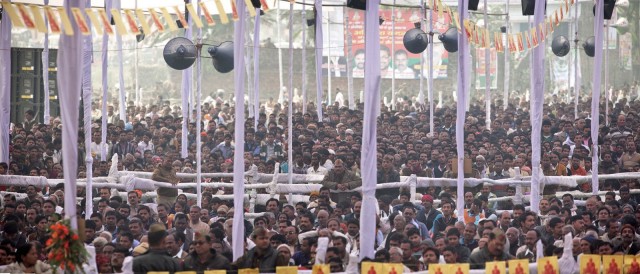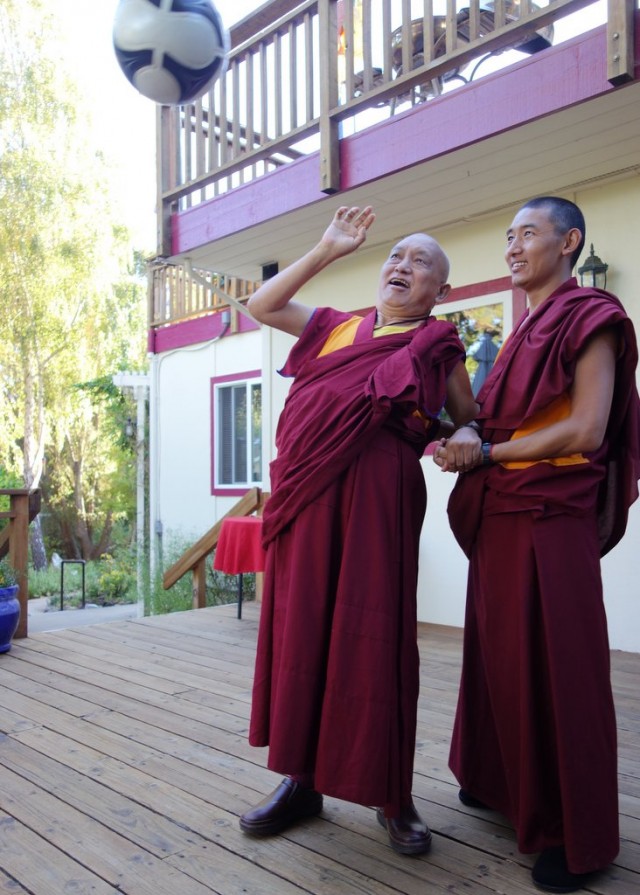- Home
- FPMT Homepage
Foundation for the Preservation of the Mahayana Tradition
The FPMT is an organization devoted to preserving and spreading Mahayana Buddhism worldwide by creating opportunities to listen, reflect, meditate, practice and actualize the unmistaken teachings of the Buddha and based on that experience spreading the Dharma to sentient beings. We provide integrated education through which people’s minds and hearts can be transformed into their highest potential for the benefit of others, inspired by an attitude of universal responsibility and service. We are committed to creating harmonious environments and helping all beings develop their full potential of infinite wisdom and compassion. Our organization is based on the Buddhist tradition of Lama Tsongkhapa of Tibet as taught to us by our founders Lama Thubten Yeshe and Lama Thubten Zopa Rinpoche.
- Willkommen
Die Stiftung zur Erhaltung der Mahayana Tradition (FPMT) ist eine Organisation, die sich weltweit für die Erhaltung und Verbreitung des Mahayana-Buddhismus einsetzt, indem sie Möglichkeiten schafft, den makellosen Lehren des Buddha zuzuhören, über sie zur reflektieren und zu meditieren und auf der Grundlage dieser Erfahrung das Dharma unter den Lebewesen zu verbreiten.
Wir bieten integrierte Schulungswege an, durch denen der Geist und das Herz der Menschen in ihr höchstes Potential verwandelt werden zum Wohl der anderen – inspiriert durch eine Haltung der universellen Verantwortung und dem Wunsch zu dienen. Wir haben uns verpflichtet, harmonische Umgebungen zu schaffen und allen Wesen zu helfen, ihr volles Potenzial unendlicher Weisheit und grenzenlosen Mitgefühls zu verwirklichen.
Unsere Organisation basiert auf der buddhistischen Tradition von Lama Tsongkhapa von Tibet, so wie sie uns von unseren Gründern Lama Thubten Yeshe und Lama Thubten Zopa Rinpoche gelehrt wird.
- Bienvenidos
La Fundación para la preservación de la tradición Mahayana (FPMT) es una organización que se dedica a preservar y difundir el budismo Mahayana en todo el mundo, creando oportunidades para escuchar, reflexionar, meditar, practicar y actualizar las enseñanzas inconfundibles de Buda y en base a esa experiencia difundir el Dharma a los seres.
Proporcionamos una educación integrada a través de la cual las mentes y los corazones de las personas se pueden transformar en su mayor potencial para el beneficio de los demás, inspirados por una actitud de responsabilidad y servicio universales. Estamos comprometidos a crear ambientes armoniosos y ayudar a todos los seres a desarrollar todo su potencial de infinita sabiduría y compasión.
Nuestra organización se basa en la tradición budista de Lama Tsongkhapa del Tíbet como nos lo enseñaron nuestros fundadores Lama Thubten Yeshe y Lama Zopa Rinpoche.
A continuación puede ver una lista de los centros y sus páginas web en su lengua preferida.
- Bienvenue
L’organisation de la FPMT a pour vocation la préservation et la diffusion du bouddhisme du mahayana dans le monde entier. Elle offre l’opportunité d’écouter, de réfléchir, de méditer, de pratiquer et de réaliser les enseignements excellents du Bouddha, pour ensuite transmettre le Dharma à tous les êtres. Nous proposons une formation intégrée grâce à laquelle le cœur et l’esprit de chacun peuvent accomplir leur potentiel le plus élevé pour le bien d’autrui, inspirés par le sens du service et une responsabilité universelle. Nous nous engageons à créer un environnement harmonieux et à aider tous les êtres à épanouir leur potentiel illimité de compassion et de sagesse. Notre organisation s’appuie sur la tradition guéloukpa de Lama Tsongkhapa du Tibet, telle qu’elle a été enseignée par nos fondateurs Lama Thoubtèn Yéshé et Lama Zopa Rinpoché.
Visitez le site de notre Editions Mahayana pour les traductions, conseils et nouvelles du Bureau international en français.
Voici une liste de centres et de leurs sites dans votre langue préférée
- Benvenuto
L’FPMT è un organizzazione il cui scopo è preservare e diffondere il Buddhismo Mahayana nel mondo, creando occasioni di ascolto, riflessione, meditazione e pratica dei perfetti insegnamenti del Buddha, al fine di attualizzare e diffondere il Dharma fra tutti gli esseri senzienti.
Offriamo un’educazione integrata, che può trasformare la mente e i cuori delle persone nel loro massimo potenziale, per il beneficio di tutti gli esseri, ispirati da un’attitudine di responsabilità universale e di servizio.
Il nostro obiettivo è quello di creare contesti armoniosi e aiutare tutti gli esseri a sviluppare in modo completo le proprie potenzialità di infinita saggezza e compassione.
La nostra organizzazione si basa sulla tradizione buddhista di Lama Tsongkhapa del Tibet, così come ci è stata insegnata dai nostri fondatori Lama Thubten Yeshe e Lama Zopa Rinpoche.
Di seguito potete trovare un elenco dei centri e dei loro siti nella lingua da voi prescelta.
- 欢迎 / 歡迎
简体中文
“护持大乘法脉基金会”( 英文简称:FPMT。全名:Foundation for the Preservation of the Mahayana Tradition) 是一个致力于护持和弘扬大乘佛法的国际佛教组织。我们提供听闻,思维,禅修,修行和实证佛陀无误教法的机会,以便让一切众生都能够享受佛法的指引和滋润。
我们全力创造和谐融洽的环境, 为人们提供解行并重的完整佛法教育,以便启发内在的环宇悲心及责任心,并开发内心所蕴藏的巨大潜能 — 无限的智慧与悲心 — 以便利益和服务一切有情。
FPMT的创办人是图腾耶喜喇嘛和喇嘛梭巴仁波切。我们所修习的是由两位上师所教导的,西藏喀巴大师的佛法传承。
繁體中文
護持大乘法脈基金會”( 英文簡稱:FPMT。全名:Found
ation for the Preservation of the Mahayana Tradition ) 是一個致力於護持和弘揚大乘佛法的國際佛教組織。我們提供聽聞, 思維,禪修,修行和實證佛陀無誤教法的機會,以便讓一切眾生都能 夠享受佛法的指引和滋潤。 我們全力創造和諧融洽的環境,
為人們提供解行並重的完整佛法教育,以便啟發內在的環宇悲心及責 任心,並開發內心所蘊藏的巨大潛能 — 無限的智慧與悲心 – – 以便利益和服務一切有情。 FPMT的創辦人是圖騰耶喜喇嘛和喇嘛梭巴仁波切。
我們所修習的是由兩位上師所教導的,西藏喀巴大師的佛法傳承。 察看道场信息:
- FPMT Homepage
- News/Media
-
- Study & Practice
-
-
- About FPMT Education Services
- Latest News
- Programs
- New to Buddhism?
- Buddhist Mind Science: Activating Your Potential
- Heart Advice for Death and Dying
- Discovering Buddhism
- Living in the Path
- Exploring Buddhism
- FPMT Basic Program
- FPMT Masters Program
- FPMT In-Depth Meditation Training
- Maitripa College
- Lotsawa Rinchen Zangpo Translator Program
- Universal Education for Compassion & Wisdom
- Online Learning Center
-
- Prayers & Practice Materials
- Overview of Prayers & Practices
- Full Catalogue of Prayers & Practice Materials
- Explore Popular Topics
- Benefiting Animals
- Chenrezig Resources
- Death & Dying Resources
- Lama Chopa (Guru Puja)
- Lama Zopa Rinpoche: Compendium of Precious Instructions
- Lama Zopa Rinpoche: Life Practice Advice
- Lama Zopa Rinpoche Practice Series
- Lamrim Resources
- Mantras
- Prayer Book Updates
- Purification Practices
- Sutras
- Thought Transformation (Lojong)
- Audio Materials
- Dharma Dates - Tibetan Calendar
- Translation Services
- Publishing Services
- Ways to Offer Support
- Prayers & Practice Materials
-
- Teachings and Advice
- Find Teachings and Advice
- Lama Zopa Rinpoche Advice Page
- Lama Zopa Rinpoche: Compendium of Precious Instructions
- Lama Zopa Rinpoche Video Teachings
- ༧སྐྱབས་རྗེ་བཟོད་པ་རིན་པོ་ཆེ་མཆོག་ནས་སྩལ་བའི་བཀའ་སློབ་བརྙན་འཕྲིན།
- Podcasts
- Lama Yeshe Wisdom Archive
- Buddhism FAQ
- Dharma for Young People
- Resources on Holy Objects
- Teachings and Advice
-
-
*If a menu item has a submenu clicking once will expand the menu clicking twice will open the page.
-
-
- Centers
-
- Teachers
-
- Projects
-
-
-
-
*If a menu item has a submenu clicking once will expand the menu clicking twice will open the page.
-
-
- FPMT
-
-
-
-
-
Actions that give harm to other sentient beings aren’t those of a bodhisattva. In Buddhism, there’s no such thing as a holy war. You have to understand this. It’s impossible to equalize everybody on earth through force.
Lama Thubten Yeshe
-
-
-
- Shop
-
-
-
The Foundation Store is FPMT’s online shop and features a vast selection of Buddhist study and practice materials written or recommended by our lineage gurus. These items include homestudy programs, prayers and practices in PDF or eBook format, materials for children, and other resources to support practitioners.
Items displayed in the shop are made available for Dharma practice and educational purposes, and never for the purpose of profiting from their sale. Please read FPMT Foundation Store Policy Regarding Dharma Items for more information.
-
-
Mandala
27
FPMT in Mongolia 1999-2012
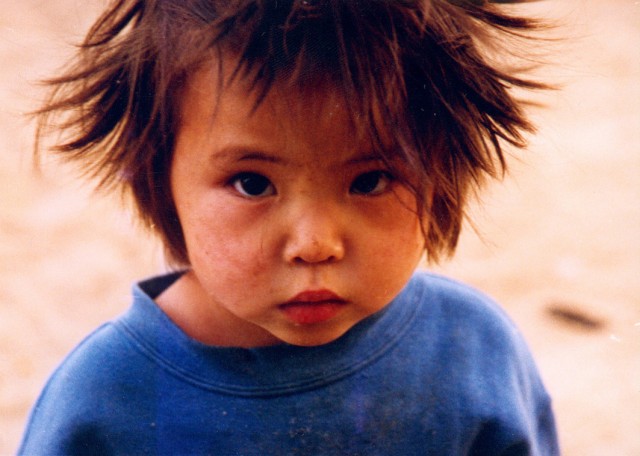
Orphan girl, Mongolia, 2001. Photo by Ueli Minder. Ueli Minder arrived in Mongolia in October 2000 and served FPMT Mongolia in a variety of positions until 2009.
Lama Zopa Rinpoche visited Mongolia for the first time in 1999 at the invitation of Bakula Rinpoche, who had already been working for 10 years to reestablish Buddhism in the country, and a small group of Mongolians that included a young journalist named Batbold Baast. Baast explained to Rinpoche how important it was for high lamas to come to Mongolia and teach because many Mongolians were being converted by Christian missionaries and losing their Buddhist heritage. Due to Lama Zopa Rinpoche’s wish to help, FPMT Mongolia became a registered Mongolian religious organization in 1999 and a few dedicated FPMT students moved to Ulaanbaatar to begin work. Over the last 13 years, more than 40 Westerners and hundreds of Mongolians have developed an organization that provides Dharma education and Sangha support in addition to social services for some of Mongolia’s needy.
Ueli Minder, who first arrived in Mongolia in 2001, and Ven. Sarah Thresher, who began work in Mongolia in 2004, shared a few of their photos as part of Mandala’s January-March 2014 online content to illustrate some of the activities that FPMT Mongolia has been involved with over the years.
From Mandala January-March 2014
26
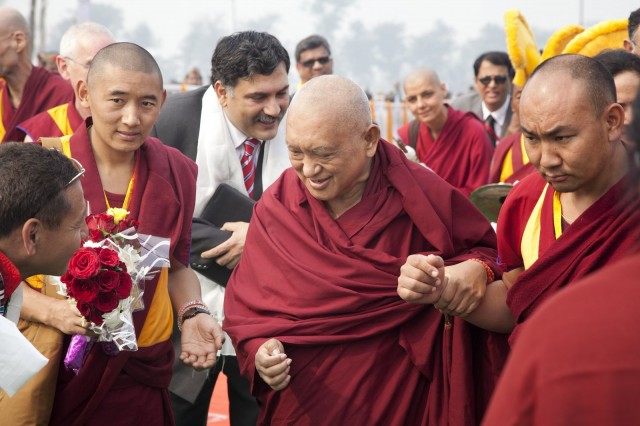
Lama Zopa Rinpoche arriving at Maitreya Project foundation stone laying ceremony, Kushinagar, India, December 13, 2013. Photo by Andy Melnic.
“There is great loving kindness in the heart of the Buddha for us, from time without beginning, as the continuity of our life is beginningless. So, until full enlightenment is achieved, the Buddha has loving kindness for us,” Lama Zopa Rinpoche explained in a 2005 message thanking all the Dharma centers for making prayers to benefit the Maitreya Project.
“Maitreya Buddha is the embodiment of each buddha’s loving kindness, and the symbol of all the bodhisattvas’ loving kindness for all sentient beings.
“Peace experienced throughout the entire universe, global peace, national peace, and each individual’s peace comes from the good heart, loving kindness. Maitreya Buddha is a symbol of this.”
You can read Rinpoche’s complete message in “Maitreya Project: Thanks for Prayers and Donations” on the Lama Yeshe Wisdom Archive.
The Maitreya Project is an FPMT project to build a very large statue of Maitreya Buddha in India. To learn about recent developments in Kushinagar, see Lama Zopa Rinpoche’s speech given at the Maitreya Project foundation stone laying ceremony and read Ven. Thubten Labdron’s report and Ven. Gyalten Samten’s reflections on the event.
Lama Zopa Rinpoche is the spiritual director of the Foundation for the Preservation of Mahayana Tradition (FPMT), an organization dedicated to preserving Mahayana Buddhism through offering the Buddha’s authentic teachings and to facilitating reflection, meditation, practice and the opportunity to actualize and directly experience the Buddha’s teachings. Sign up to receive news and updates.
- Tagged: lama zopa rinpoche, maitreya projects, mandala
- 0

Lama Zopa Rinpoche with Ven. Kabir Saxena before the Maitreya Project ceremony, Kushinagar, India, December 13, 2013. Photo by Ven. Roger Kunsang.
While attending the foundation stone laying ceremony for the Maitreya Project, Lama Zopa Rinpoche signed a special edition of a Maitreya envelope, issued by the Indian postal service to commemorate the December 13 event on the new land in Kushinagar. The envelope will be distributed to more than 40 countries. Rinpoche and Uttar Pradesh Chief Minister Akhilesh Yadav signed about 15-20 envelopes as collectors’ items.
For more, see Lama Zopa Rinpoche’s speech given at the ceremony and read Ven. Thubten Labdron’s report and Ven. Gyalten Samten’s reflections on the event.
Lama Zopa Rinpoche is the spiritual director of the Foundation for the Preservation of Mahayana Tradition (FPMT), an organization dedicated to preserving Mahayana Buddhism through offering the Buddha’s authentic teachings and to facilitating reflection, meditation, practice and the opportunity to actualize and directly experience the Buddha’s teachings. Sign up to receive news and updates.
- Tagged: kushinagar, lama zopa rinpoche, maitreya buddha project kushinagar, maitreya projects, mandala
- 0
24

Long life puja for Lama Zopa Rinpoche, Drati Khangsten, Sera Je Monastic University, India, December 22, 2013. Photo by Ven. Roger Kunsang.
A long life puja for Lama Zopa Rinpoche was held on December 22, 2013, at Drati Khangtsen, Sera Je Monastic University in South India. ”So many people attended, 70 FPMT Centers were represented, 17 FPMT Geshes were present and so many overseas students, more than a thousand monks and lay people,” shared Ven. Roger Kunsang, Lama Zopa Rinpoche’s assistant. ”The puja went very well, coming at the end of this period of lungs of the Most Secret Hayagriva transmission.”
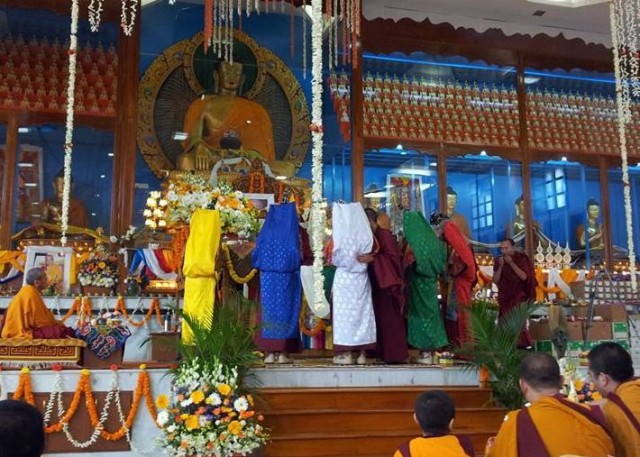
The five dakinis during the long life puja for Lama Zopa Rinpoche, Drati Khangstan, Sera Je Monastic University, India, December 22, 2013. Photo by Fabrizio Palloti.
More information, photos and updates about FPMT spiritual director Lama Zopa Rinpoche can be found on Rinpoche’s homepage. If you’d like to receive news of Lama Zopa Rinpoche via email, sign up to Lama Zopa Rinpoche News.
23
The 100 Million Mani Retreat in Mongolia Photo Gallery
The 100 Million Mani Retreat in Mongolia, hosted by FPMT Mongolia, brought together several hundred Mongolians and 70 non-Mongolian students for one month of intense practice and chanting OM MANI PADME HUM. The accomplishment of the 100 Million Mani Retreat had been a particularly strong wish of Lama Zopa Rinpoche to help revive Buddhism in the historically Buddhist country. The retreat began on August 1, 2013, at Idgaa Choizinling Dratsang in the Ganden Monastery complex in Ulaanbaatar.
Lama Zopa Rinpoche arrived at the retreat in mid-August, bringing great joy to the retreat participants. The retreat concluded on August 30 with a long life puja for Lama Zopa Rinpoche. A total of 108,939,500 mani mantras were recited. As part of the January-March 2014 online content, we offer you a collection of photos from the retreat itself and Rinpoche’s two-week stay in the country afterward.
From Mandala January-March 2014
20
A Day in the Life in Mongolia
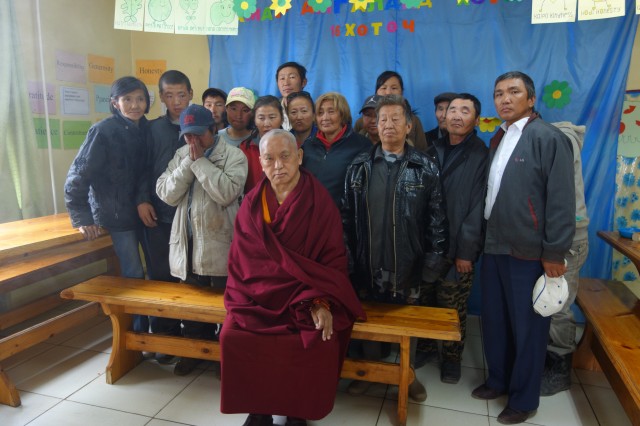
Lama Zopa Rinpoche with Lamp of the Path staff and beneficiaries, Ulaanbaatar, Mongolia, September 3, 2013. Photo by Ven. Roger Kunsang.
Conditions are very difficult for the poor living in Mongolia, especially given the long, cold winters. The Lamp of the Path NGO, part of FPMT Mongolia, offers social services to some of the poor and homeless living in Ulaanbaatar, Mongolia. It has three main programs: a soup kitchen, which offers about 80 meals five days a week; a health clinic, which offers free health services to the very poor; and a tailors’ cooperative, which helps single mothers earn a living and to become financially self-sufficient. FPMT Mongolia also has started an alcohol treatment program in cooperation with the Ulaanbaatar Police Department.
Massimo Corona lived in Ulaanbaatar 2011-12 and witnessed first-hand the excruciating circumstances that some of the people who come to Lamp of the Path experience. For the January-March 2014 issue of Mandala, he shared one heartbreaking story.
On a very cold winter day (-30° C [-22° F]) in 2011, I went to visit the Lamp of the Path (LOP) NGO Soup Kitchen to film the activity there for a fundraising appeal. Every day LOP offers free soup for lunch to the homeless and destitute of that district of Ulaanbaatar, the capital city of Mongolia.
I wanted to start where these people lived. We began at a manhole leading to central heating pipes, which created a warm space underground. A young lady came out first. She had severe burns on her legs from the heating pipes which are being treated by LOP’s doctor. Then a totally blind man came out. He walks alone everyday to the soup kitchen from the manhole, about two kilometers (one mile). I looked inside and what I saw was only a bed of straw. Everything else was covered in black soot. …
From Mandala January-March 2014
FPMT spiritual director Lama Zopa Rinpoche will offer His Holiness the Dalai Lama a hand-beaded White Tara thangka when Rinpoche sees His Holiness in December in South India. His Holiness will be continuing the teaching and transmission of the Jangchup Lamrim at Sera Monastic University from December 25, 2013 to January 3, 2014.
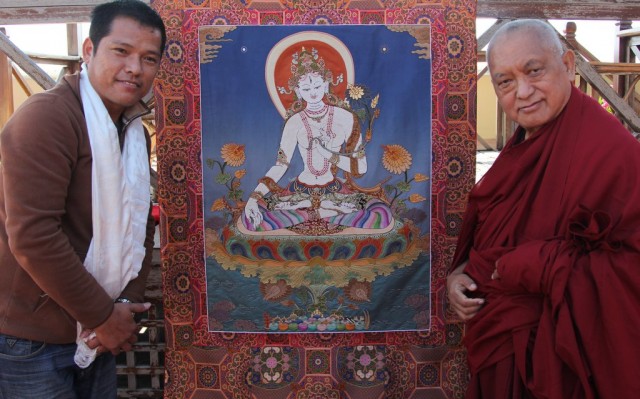
Lama Zopa Rinpoche and artist of White Tara beaded thangka that will be offered to His Holiness the Dalai Lama, November 2013. Photo by Ven. Roger Kunsang.
More information, photos and updates about FPMT spiritual director Lama Zopa Rinpoche can be found on Rinpoche’s homepage. If you’d like to receive news of Lama Zopa Rinpoche via email, sign up to Lama Zopa Rinpoche News.
19

Lama Zopa Rinpoche being greeted upon arrival at the ceremony, Kushinagar, India, December 13, 2013. Photo by Andy Melnic.
By Ven. Gyalten Samten
The Maitreya Project is an FPMT project to build a very large statue of Maitreya, the future buddha, in Kushinagar and Bodhgaya. Just last week, the project took an enormous step forward, receiving land upon which to build from the Uttar Pradesh state government. Ven. Gyalten Samten was part of a team overseeing aspects of the foundation stone laying ceremony held on Friday, December 13, 2013. She shared with Mandala her experience of the historic event.
On December 13, 2013, history of sorts was created in Kushinagar, Uttar Pradesh, India. On that misty morning, what unfolded could be a scene from a Bollywood potboiler. A helicopter lands, interrupting the peaceful quiet. Lama Zopa Rinpoche, accompanied by Maitreya Project trustee Sanjeev Chaudhry, emerges. We were all in tow, welcoming them in the traditional Tibetan style, with the monks chanting, playing cymbals and gyalings.
Then another helicopter lands and the chief minister of Uttar Pradesh, Akhilesh Yadav, enters the scene. More greetings. And a crowd of over 100,000 farmers and locals, Buddhist monks and other dignitaries has gathered, eager to see the holy guru and the chief minister.
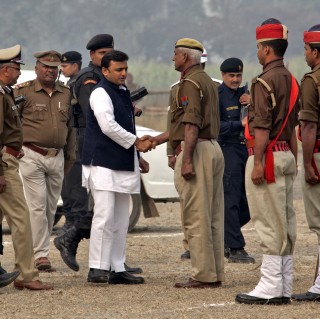
Uttar Pradesh Chief Minister Akhilesh Yadav arriving at the ceremony, Kushinagar, India, December 13, 2013. Photo by Andy Melnic.
Kushinagar, a small non-descript town, is popularly known as the place of the last leg of Shakyamuni Buddha’s journey before he passed into parinirvana. Innumerable precious relics were found after the Buddha’s cremation, which were divided amongst eight kingdoms. The Mallas of Kushinagar built a stupa to store the precious relics of Buddha.
Starting in the 1980s, Lama Yeshe had a grand vision of building a large Maitreya statue in India. Lama Zopa Rinpoche took this vision forward and the project has developed to build a 500-foot (152-meter) statue. One of the first things to do was to acquire land to carry out this mammoth task. The chosen place was Bodhgaya. Due to many factors, the Maitreya Project struggled for 13 long years. Lama Zopa Rinpoche sought advice from His Holiness the Dalai Lama regarding the project, having watched it face many obstacles for many years. It was confirmed to build a Maitreya Buddha statue in Kushinagar as this was the place of parinirvana of Shakyamuni Buddha.
Obstacles to acquiring land continued to arise in Kushinagar, and after another 13 years of planning and waiting, when everyone had nearly given up hope, the trustees sent a letter to the new chief minister of Uttar Pradesh, Akhilesh Yadav, withdrawing the project. But the chief minister took notice and approved 200 acres (81 hectares) of land to be given to the Maitreya Project immediately.
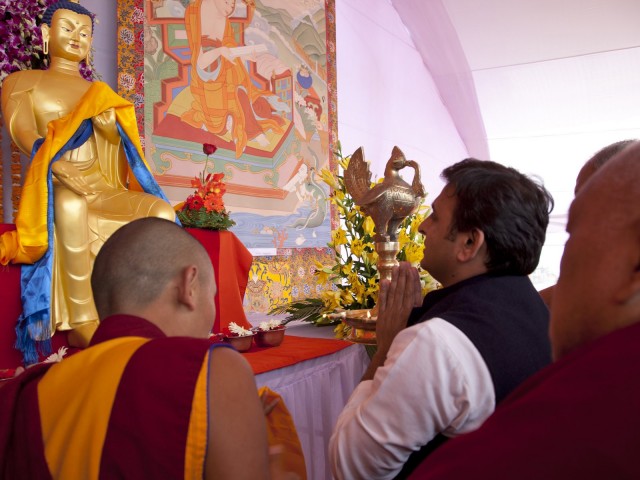
Uttar Pradesh Chief Minister Akhilesh Yadav with Lama Zopa Rinpoche, Kushinagar, India, December 13, 2013. Photo by Andy Melnic.
The Uttar Pradesh state government and Maitreya Project trustees agreed on December 13 for the formal laying of the foundation stone – a grand event that was to be organized in less than a week. Since the chief minister was going to attend, the event assumed a political flavor, which meant arrangements needed to accommodate hundreds of thousands of people.
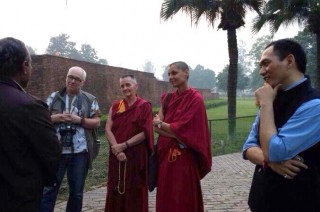
Andy Melnic, Ven. Labdron, Ven. Samten and District Magistrate Rigzin Samphel, Kushinagar, India, December 2013. Photo courtesy of Rigzin Samphel.
A team of three people – director of Root Institute Ven. Thubten Labdron, photographer Andy Melnic and myself – were sent to oversee the arrangements and coordinate the cultural and religious aspects of the event. A team of a dozen monks from Kopan Monastery, a replica of the Maitreya Buddha statue from Root Institute in Bodhgaya and a dance troupe from Dharamsala were en route to Kushinagar as well.
This was an alien ground for all of us. Even before we could get our bearings, we were in the thick of meetings with the local dignitaries, the commissioner and the cultural director.
The district magistrate of Kushinagar, Rigzin Samphel, turned out to be our knight in shining armor. Rigzin Samphel is a Ladhaki and is very devoted to this cause and to Lama Zopa Rinpoche. When we arrived in Kushinagar, he took us to the new Maitreya Project land of which 40 acres (16 hectares) was being turned into the event site, including two helipads, two stages, a green room, a rest area for dignitaries and a parking lot for the siren-blaring vehicles of politicians.
During our first visit to the site, I asked sheepishly how big the land given to the Maitreya Project was. “For as far as your eyes can see, Samten-la, is Maitreya land,” Rigzin Samphel replied. “Incredible,” I murmured, overwhelmed with the sight of lush green farmland and the thought of all the hardships everyone associated with the project has faced to acquire it and realize a profound dream of the holy guru. Rigzin Samphel further remarked that all the farmers were compensated suitably for the land.
Amongst much fanfare and great aplomb, Lama Zopa Rinpoche and Chief Minister Akhilesh Yadav laid the foundation stone for the Maitreya Project.
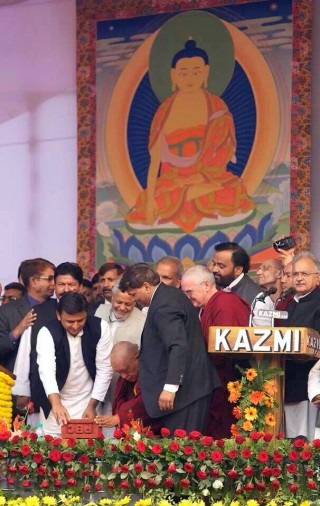
Laying the foundation stone, Kushinagar, India, December 13, 2013. Photo courtesy of Rigzin Samphel.
Rinpoche addressed the audience, profusely thanking the farmers who gave up their land and all in attendance for their support and enthusiasm. Rinpoche also explained the great benefits of building the Maitreya Buddha statue and that the FPMT will commence work on the project very quickly, starting with setting up a health clinic for the local residents, and that the project will bring prosperity for the people by eventually employing many hundreds of people. Ven. Kabir Saxena simultaneously translated Rinpoche’s speech into Hindi.
Chief Minister Akhilesh Yadav emphasized the profundity of the project and how it will give a great boost to the tourism and economy of the state during his speech. Moreover, he urged the trustees of the Maitreya Project to start the work quickly.
This is just the beginning of a dream unleashed on the holy land of Kushinagar. Maitreya Buddha will manifest in ways far beyond our imagination, all we need to do is to continue to create causes for this and never give up.
We extend our deepest gratitude to all the trustees of the Maitreya Project and all the devotees who have believed in the vision of Lama Yeshe and Lama Zopa Rinpoche.
Ven. Gyalten Samten is an Indian nun. Before ordaining, she had an active career as an actress in Bollywood movies and once held the title “Miss India.”
For more, read Lama Zopa Rinpoche’s remarks made at the foundation stone laying ceremony and Ven. Thubten Labdron’s report on arranging the big event in only five days.
Mandala’s ongoing coverage of the Maitreya Project can be read online.
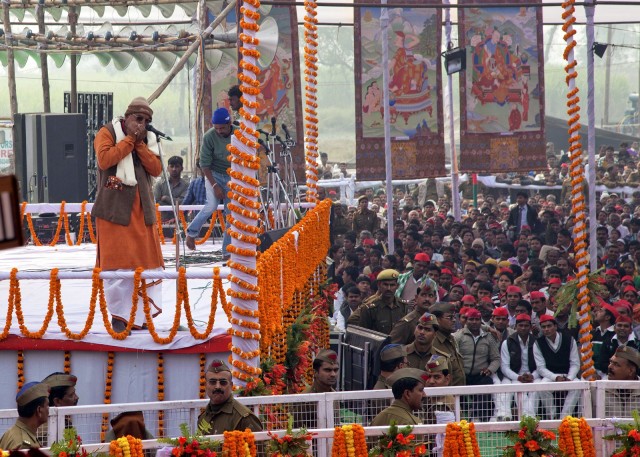
Part of the cultural program at the ceremony, Kushinagar, India, December 13, 2013. Photo by Andy Melnic.
Mandala brings you news of Lama Zopa Rinpoche and of activities, teachings and events from over 160 FPMT centers, projects and services around the globe. If you like what you read on Mandala, consider becoming a Friend of FPMT, which supports our work.
- Tagged: kushinagar, lama zopa rinpoche, maitreya buddha project kushinagar, maitreya projects, mandala, ven. gyalten samten, ven. thubten labron
- 0
19
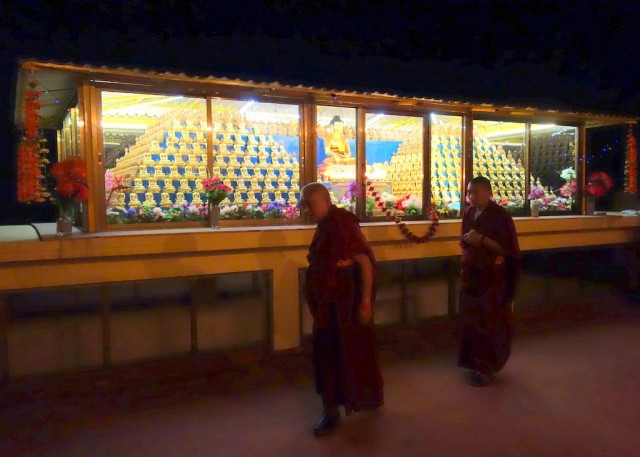
Lama Zopa Rinpoche circumambulating at night the 1,000 buddhas at Kopan Monastery, Nepal, December 2, 2013. Photo by Ven. Roger Kunsang.
“On every atom are buddhas numberless as atoms,
Each amidst a host of bodhisattvas,
And I am confident the sphere of all phenomena
Is entirely filled with buddhas in this way.”
– From “King of Prayers – The Extraordinary Aspiration of the Practice of Samantabhadra”
Lama Zopa Rinpoche is the spiritual director of the Foundation for the Preservation of Mahayana Tradition (FPMT), an organization dedicated to preserving Mahayana Buddhism through offering the Buddha’s authentic teachings and to facilitating reflection, meditation, practice and the opportunity to actualize and directly experience the Buddha’s teachings. Sign up to receive news and updates.
- Tagged: circumambulation, lama zopa rinpoche, mandala
- 0
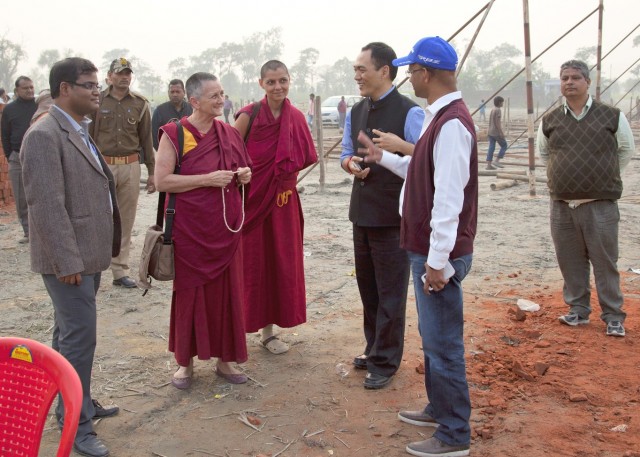
Vens. Labdron and Samten with District Magistrate Rigzin Samphel visiting the ceremony site as it is being built, Kushinagar, India, December 9, 2013. Photo by Andy Melnic.
By Ven. Thubten Labdron
The Maitreya Project took an enormous step forward in its work to build a very large bronze statue of Maitreya Buddha, the future buddha, in Kushinagar, India, the holy site of Buddha Shakyamuni’s parinirvana. The Uttar Pradesh State Government handed over a large tract of land that it had offered to the Maitreya Project for the Maitreya statue to be built upon. The handover of the land was marked by a foundation stone laying ceremony on Friday, December 13, 2013. Ven. Thubten Labdron, director of Root Institute in Bodhgaya, was asked to be part of the team overseeing the religious and cultural aspects of the event. She shared with Mandala this report on how the ceremony came together in less than a week.
Ten days ago, Indian nun Ven. Gyalten Samten, photographer Andy Melnic and I were unexpectedly thrown together for a unique experience. One day, we were enjoying Lama Zopa Rinpoche’s teachings at Kopan Monastery in Nepal, anticipating offering the annual long life puja to Rinpoche. The next, we were on our way to Kushinagar, India, for the Maitreya Project, not knowing what exactly we were heading into.
We were met in Kushinagar by District Magistrate Rigzin Samphel, who also had arranged our hotel. Atul Chopra, the Maitreya Project lawyer, was in Lucknow dealing with some last minute legal details. The hotel quickly turned into the central administration hub, with small, medium and very important officials and ministers coming and going, with sirens blaring and surrounded by security guards.
The final decision on the land for the Maitreya Project in Kushinagar had only been made two days before, but when we visited the venue, we found they had already flattened 40 acres [16 hectares] of land, erected an enormous tent scaffolding and almost completed two helipads. A 30 x 20 foot [9 x 6 meter] stage was half built, and there was a drivable dirt road. It looked like 20 construction sites in one.
We were fortunate to arrive before the activities became super hectic. The district magistrate made time to take us personally – with an entourage of bodyguards – to the Parinirvana Temple and the cremation stupa, two holy sites in Kushinagar associated with the historical Buddha’s passing away. The peaceful energy in those places is palpable, amazingly conducive to effortless meditation. Kushinagar is still underdeveloped, which is both good and not so good.
The next day we were escorted by an excellent tourist guide, Mr. Mishra, to the village where the Buddha took his last meal in the house of Cunda. There is a plaque with a touching extract from the Maha Parinirvana Sutra, titled “Relieving Cunda’s Remorse.” It says:
“Ananda … there are two offerings of food which are of equal fruition, exceeding in grandeur the fruition and result of any other offerings of food. Which two? The one partaken by the Tathagata before becoming fully enlightened … and the one partaken by the Tathagata before passing into the state of Nirvana in which no element of clinging remains.
“By his deed, the worthy Cunda has accumulated merit which makes for long life, beauty, well being, glory, heavenly rebirth and sovereignty. Thus, Ananda, the remorse of Cunda the metalworker should be dispelled.”
One can imagine how Cunda had been suffering in order to have Buddha so explicitly make that point!
We also visited the riverside site where the Buddha took his last bath on the way to Kushinagar and the ruins of a small monastery and stupa that had previously contained one part of Buddha’s holy relics. All of these three sites are clean and well maintained, with new statues of Buddha and explanatory plaques. After another visit to the Maitreya Project venue, we visited a site near the cremation stupa where the holy relics of Buddha were distributed to eight different kings.
During the days building up to the foundation stone laying ceremony, vehicles fitted with loudspeakers roamed along the Kushinagar roads, playing music and informing people about the Maitreya Project and how beneficial it will be to the local community, no matter what religion, bringing employment, recognition, peace and harmony, and exhorting them to attend the function.
The district magistrate, the commissioner (who oversees the four district magistrates of the Gorakpur area), and the local minister, Mr. Brahma Shankar Tripathi, had all been instrumental in bringing about the signing of the land deeds, alongside the untiring efforts of Atul Chopra and Peter Kedge, who continued working behind the scenes when the project had almost been given up. We are most fortunate that District Magistrate Rigzin Samphel was posted to Kushinagar two years ago and took an active interest in the project, and that a new chief minister of Uttar Pradesh, Akhilesh Yadav, was elected. (He’s now the youngest chief minister in India.) It has to be the fruition of all the prayers, practices and dedications made by so many people.
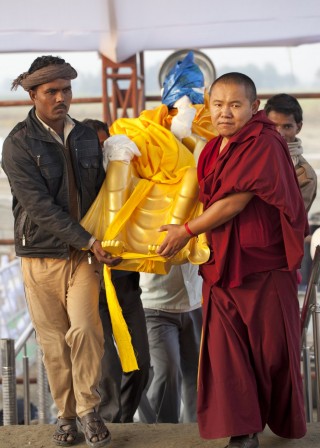
Maitreya Buddha statue from Maitreya School at Root Institute, Kushinagar, India, December 12, 2013. Photo by Andy Melnic.
Two days after our arrival, 11 Kopan monks arrived, led by Geshe Lobsang Sherab and Ven. Ngawang Thinley. They brought with them huge thangkas of the eight great Indian pandits plus costumes for performing ritual dance. At the same time, the Root Institute vegetable shopping jeep arrived from Bodhgaya with the life-size statue of Maitreya Buddha sitting majestically in the back, borrowed from Maitreya School assembly hall. Ven. Yonden accompanied the statue, so we soon had a working team of monks, jeeps and drivers all soon involved in the program and decorations.
Meetings were held each night with the district magistrate and other officials to update each other on Lama Zopa Rinpoche’s latest advice and program changes from the government. Fortunately, we FPMT wallahs are very well-trained in accepting change!
The day before the event, the town was literally filled with thousands of lathe-carrying policemen on motorbikes; very important police officials with many badges and stars; zillions of ambassadorial cars with blue flashing lights and sirens accompanied back and front by jeeps of armed police; and press.
Maitreya Project trustees Dr. Renuka Singh, Ranjit Walia and Ven. Kabir Saxena arrived the evening before the event. A Tibetan dance troupe arrived from Dharamsala late that evening. They had performed for His Holiness the Dalai Lama the day before, on the anniversary of His Holiness receiving the Nobel Prize, then had driven for two days to reach Kushinagar in time. Vens. Kunsang, Sangpo and Tendhar arrived by car from Lucknow a couple of hours before the event.

Thangka brought from Kopan Monastery for ceremony, Kushinagar, December 12, 2013. Photo by Andy Melnic.
District Magistrate Rigzin Samphel stayed at the venue the whole night to ensure everything was completed in time. By 9 a.m. on Friday, December 13, a magnificent flower display was completed with flowers from Delhi as well as the local state, Uttar Pradesh; the thangkas were being hung high; Maitreya Buddha was seated on a flower-adorned throne on stage; the gifts were all ready for distribution; and the atmosphere was peaceful.
It was amazing after watching the frenetic activities of the last few days. The whole venue had been completed in only five days, including two “Swiss Cottage” restrooms for Rinpoche and the chief minister. A separate stage was constructed adjacent to the main stage for the performers.
A local cultural program started exactly on time to entertain the crowds who had started to arrive early in the morning.
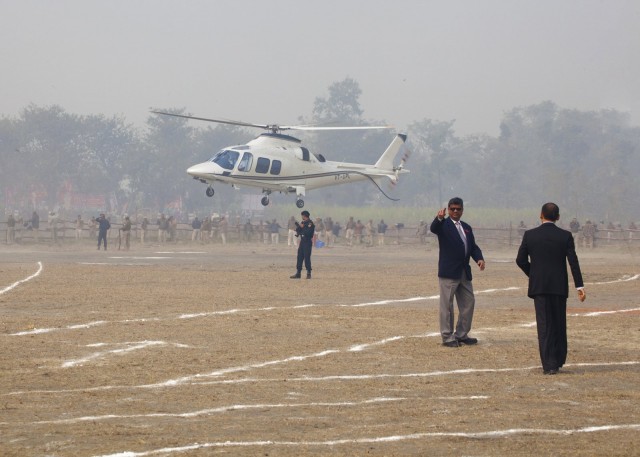
Helicopter carrying Lama Zopa Rinpoche landing at Kushinagar, India, December 13, 2013. Photo by Andy Melnic.
From 10 a.m., we were waiting for Rinpoche to arrive. The monks were lined up with musical instruments. The dancers were in costume. And the excitement was intense as we heard the sound of Rinpoche’s helicopter. It was a very emotional moment as it landed and Rinpoche emerged. Finally, Maitreya Project Kushinagar was happening! Rinpoche was accompanied by Mr. Sanjeev Chowdhury and his wife. Sanjeev has been very instrumental in making this happen.
Then the chief minister’s helicopter arrived and was quickly surrounded by commandos, heavy security vehicles and political party officials. Rinpoche, along with the monks and the trustees, greeted Chief Minister Akhilesh Yadav, and the event got under way.
The tourism minister, cultural minister, local minister, inspector general of police and many other ministers and officials filled the stage. The program went mostly according to plan, with speeches by various ministers; Ven. Kabir explained that the monks’ ritual masked dances were actually to dispel obstacles for the good of all, not a threat; and Sanjeev Chowdhury shared the many benefits that Maitreya Project will bring by putting Kushinagar on the world map. Rinpoche gave a lovely talk, translated by Ven. Kabir, on the benefits of the project and on the eight Indian pandits. Between the speeches, Rinpoche and the chief minister unveiled the commemorative plaque and symbolically laid the foundation stone.
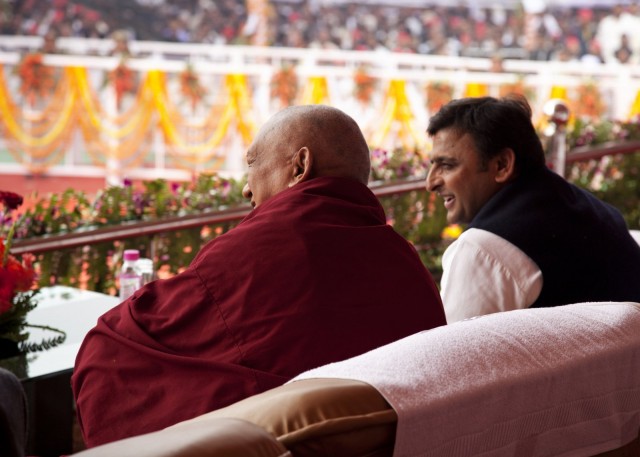
Lama Zopa Rinpoche and Akhilesh Yadav during ceremony, Kushinagar, India, December 13, 2013. Photo by Andy Melnic.
All the speakers were very positive about the project, which was good to hear. Chief Minister Akhilesh Yadav made the final speech, explaining how when he took office, he had been given a letter from the Maitreya Project saying how difficult it had been as the land had been offered 12 years earlier, but successive governments had not finalized the actual handover. He also was very positive, and said he hoped that the social work projects would start very soon so that the local people will see the benefits. The chief minister also credited the district magistrate for his work with some well-deserved praise.
An estimated 100,000 people attended the event.
After the chief minister finished his speech, he left the stage, marking the close to a perfect event. There was much good feeling. Then the two helicopters lifted off and it was all over, except for a delicious lunch in the Lotus Nikko hotel, enjoyed by politicians, hungry policemen with rifles and sub-machine guns hung over their shoulders, Maitreya Project trustees and officials, and we three — the “Maitreya Project Cultural Team.”
Ven. Thubten Labdron is the director of Root Institute for Wisdom Culture in Bodhgaya, India.
You can also read Lama Zopa Rinpoche’s remarks made at the foundation stone laying ceremony as well as Ven. Gyalten Samten’s report on it.
Mandala‘s ongoing coverage of the Maitreya Project can be read online.
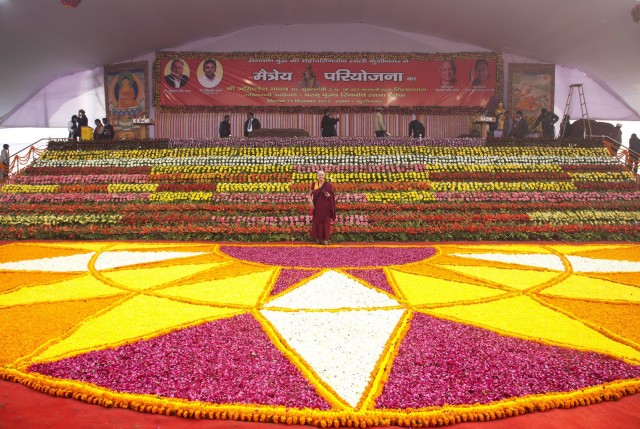
Ven. Thubten Labdron among the arranged flowers before the big event, Kushinagar, India, December 13, 2013. Photo by Andy Melnic.
Mandala brings you news of Lama Zopa Rinpoche and of activities, teachings and events from over 160 FPMT centers, projects and services around the globe. If you like what you read on Mandala, consider becoming a Friend of FPMT, which supports our work.
- Tagged: andy melnic, kushinagar, lama zopa rinpoche, maitreya buddha project kushinagar, maitreya projects, mandala, rigzin samphel, ven. gyalten samten, ven. thubten labdron (trisha donnelly)
- 1
17
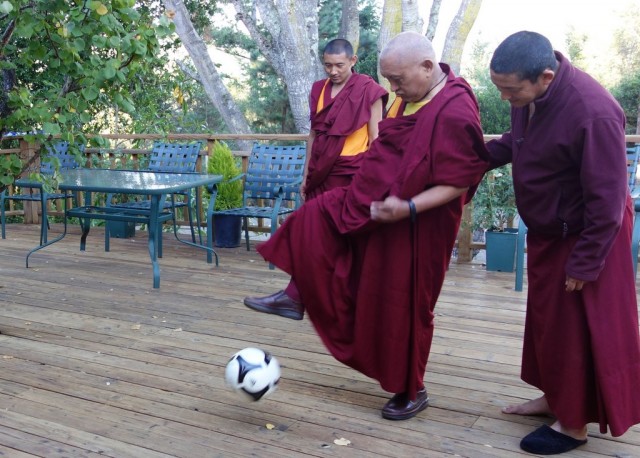
Lama Zopa Rinpoche exercising with a soccer ball, Kachoe Dechen Ling, California, October 2013. Photos by Ven. Roger Kunsang.
In October 2013, while at Kachoe Dechen Ling in California, Lama Zopa Rinpoche occasionally played with a soccer ball after lunch as a way to exercise and build up strength and coordination in his right arm and leg, which were affected by the stroke he manifested in 2011. Ven. Roger Kungsang, Rinpoche’s assistant, captured photos of Rinpoche and Sangha playing with a soccer ball one day during an exercise session.
Any movement of Rinpoche’s leg and arm on his right side is important for his recovery. Rinpoche appears to enjoy kicking and batting the soccer ball around with Sangha more than doing some of the regular physical therapy exercises. The most important part is to get Rinopche to move his arm and leg as Rinpoche mainly wants to be sitting doing practice 24 hours a day.
Tenzin Ösel Hita came to lunch on two occasions and stayed to exercise with Rinpoche.
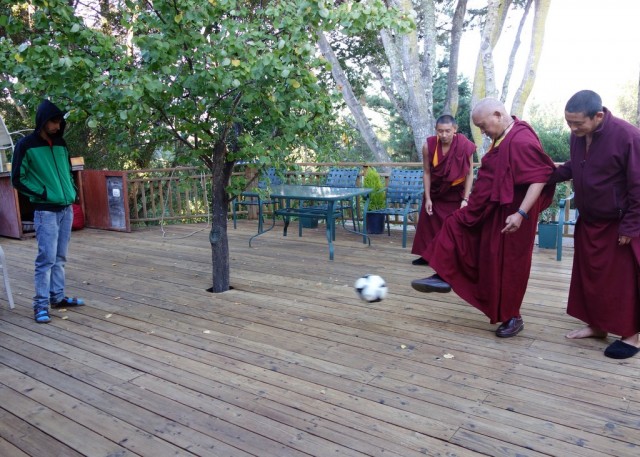
Tenzin Ösel Hita and Lama Zopa Rinpoche and his attendants playing with a soccer ball, Kachoe Dechen Ling, October 2013
Lama Zopa Rinpoche is the spiritual director of the Foundation for the Preservation of Mahayana Tradition (FPMT), an organization dedicated to preserving Mahayana Buddhism through offering the Buddha’s authentic teachings and to facilitating reflection, meditation, practice and the opportunity to actualize and directly experience the Buddha’s teachings. Sign up to receive news and updates.
- Tagged: lama zopa rinpoche, mandala, stroke, tenzin osel hita
- 0
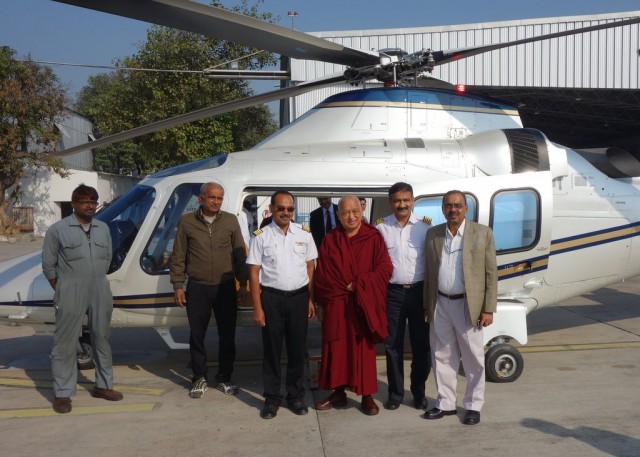
Lama Zopa Rinpoche before flying in a helicopter to Kushinagar for Maitreya Project ceremony, India, December 13, 2013. Photo by Ven. Roger Kunsang.
Lama Zopa Rinpoche was flown by the Uttar Pradesh State Government from Lucknow, India, to the site of the future Maitreya Buddha statue at Kushinagar for the foundation stone laying ceremony. Rinpoche and Akhilesh Yadev, the Chief Minister of Uttar Pradesh, addressed a crowd of 100,000 during the ceremony. The event marked the handing over of approximately 275 acres of land to the Maitreya Project Trust for the Maitreya Buddha statue.

Aerial view of ceremony site and Maitreya Project land, Kushinagar, India, December 13, 2013. Photo by Ven. Roger Kunsang.
In addition to building the Maitreya statue, the project plans to engage in a range of social programs aimed specifically at providing employment, education and healthcare to the local community. His Holiness the Dalai Lama sent a letter of good wishes that was read at the event.
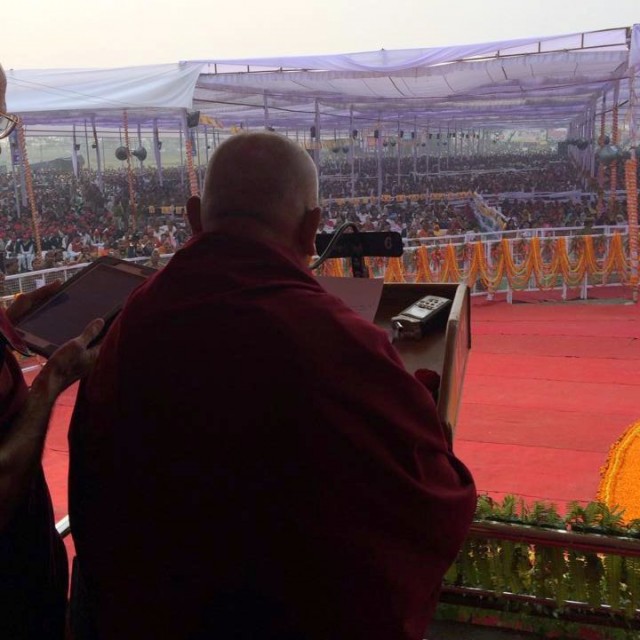
Lama Zopa Rinpoche at Maitreya Project ceremony, Kushinagar, India, December 13, 2013. Photo by Ven. Sangpo Sherpa.
For more, see the December 2013 Announcement from the Maitreya Project Kushinagar and Mandala’s coverage.
More information, photos and updates about FPMT spiritual director Lama Zopa Rinpoche can be found on Rinpoche’s homepage. If you’d like to receive news of Lama Zopa Rinpoche via email, sign up to Lama Zopa Rinpoche News.
- Home
- News/Media
- Study & Practice
- About FPMT Education Services
- Latest News
- Programs
- New to Buddhism?
- Buddhist Mind Science: Activating Your Potential
- Heart Advice for Death and Dying
- Discovering Buddhism
- Living in the Path
- Exploring Buddhism
- FPMT Basic Program
- FPMT Masters Program
- FPMT In-Depth Meditation Training
- Maitripa College
- Lotsawa Rinchen Zangpo Translator Program
- Universal Education for Compassion & Wisdom
- Online Learning Center
- Prayers & Practice Materials
- Overview of Prayers & Practices
- Full Catalogue of Prayers & Practice Materials
- Explore Popular Topics
- Benefiting Animals
- Chenrezig Resources
- Death & Dying Resources
- Lama Chopa (Guru Puja)
- Lama Zopa Rinpoche: Compendium of Precious Instructions
- Lama Zopa Rinpoche: Life Practice Advice
- Lama Zopa Rinpoche Practice Series
- Lamrim Resources
- Mantras
- Prayer Book Updates
- Purification Practices
- Sutras
- Thought Transformation (Lojong)
- Audio Materials
- Dharma Dates – Tibetan Calendar
- Translation Services
- Publishing Services
- Teachings and Advice
- Find Teachings and Advice
- Lama Zopa Rinpoche Advice Page
- Lama Zopa Rinpoche: Compendium of Precious Instructions
- Lama Zopa Rinpoche Video Teachings
- ༧སྐྱབས་རྗེ་བཟོད་པ་རིན་པོ་ཆེ་མཆོག་ནས་སྩལ་བའི་བཀའ་སློབ་བརྙན་འཕྲིན།
- Podcasts
- Lama Yeshe Wisdom Archive
- Buddhism FAQ
- Dharma for Young People
- Resources on Holy Objects
- Ways to Offer Support
- Centers
- Affiliates Area
- Teachers
- Projects
- Charitable Projects
- Make a Donation
- Applying for Grants
- News about Projects
- Other Projects within FPMT
- Support International Office
- Projects Photo Galleries
- Give Where Most Needed
- FPMT
- Shop
Subscribe to FPMT News
Translate*
*powered by Google TranslateTranslation of pages on fpmt.org is performed by Google Translate, a third party service which FPMT has no control over. The service provides automated computer translations that are only an approximation of the websites' original content. The translations should not be considered exact and only used as a rough guide.When you recognize your problem comes from your concept or your concept is the problem, you don’t blame others.







